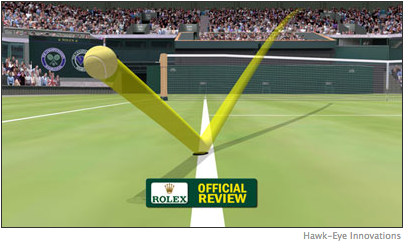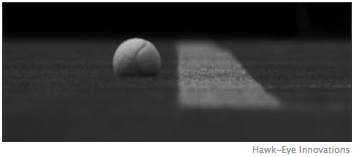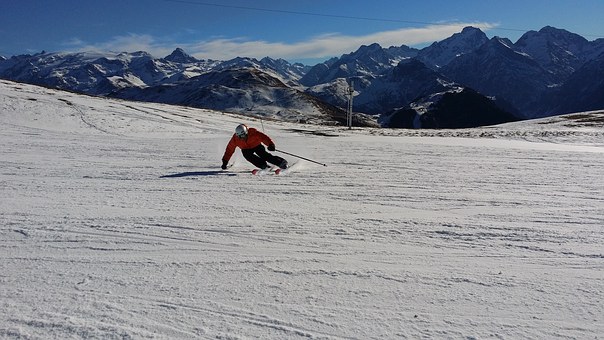The 2010 FIFA World cup highlighted one of soccer’s growing issues: incorrect calls that determine the outcomes of games. FIFA President Sepp Blatter has denied the implementation of any technology in soccer multiple times. Elsewhere in sports, tennis currently uses an electronic system called Hawk-Eye that has proven to be extremely effective at judging line calls correctly, thus minimizing human error. The system uses cameras to model the trajectory of the tennis ball to determine its position on the court at all times. The implementation of similar technology into soccer to monitor the goal line could be tremendously beneficial and have minimal effect on the actual game play, moving soccer in the right direction. Blatter has reconsidered his decision about technology in soccer and plans to address the issue at an International Football Association meeting.
A Goal to Remember
June 27, 2010, could prove to be one of the most infamous days in the history of soccer. On this day, referees for the 2010 FIFA World Cup failed to identify a goal struck by England’s Frank Lampard in a quarterfinals matchup versus Germany that ended in a 4-1 to German victory. The goal would have tied the game at a crucial 2-2 and had the potential to provide just the momentum England needed to close out the game and advance in the tournament.
Frank Lampard’s missed goal is not the first bad referee call in the history of soccer. In fact, memorable bad calls like Diego Maradona’s “Hand of God”, where striker Diego Maradona used his hand to score a goal, have been made ever since video replay has been able to capture such situations. These calls have been brought to the public spotlight because they are highlighted on television broadcasts and on stadium screens, allowing the fans and other players to see the incorrect call in real time [1].
President of FIFA Sepp Blatter largely controls the implementation of policy and rule changes to the world’s most popular game on the big stage: the FIFA World Cup. The 2010 World Cup’s numerous erroneous calls have brought increased awareness to one of soccer’s most controversial issues, even causing Blatter to reconsider implementing changes to the game that have been denied multiple times [2]. Despite push for change from unhappy fans and players, FIFA and Blatter have yet to approve the integration of technological advancements to the rules and game.
Soccer might have something to learn from tennis, a sport that has implemented the use of such technologies with great success. Hawk-Eye Innovations of Colden Common in the United Kingdom has created an officiating system that helps the line judges and the chair umpire make calls by tracking the ball’s position in three-dimensional space to determine whether the ball has landed within the court or out of play for any given shot. The innovative technology has made the game much more accurate [3]. In questionable game changing points, Hawk-Eye can be relied upon to follow the rules of the game, eliminating human error and possible injustice [4].
Hawk-Eye Technology
Introduced in 2006, Hawk-Eye Innovation’s tennis system is composed of a minimum of eight high speed cameras strategically located around the court that track the position of the ball while it is in play. The data is sent to a computer system that analyzes and interprets the ball’s position to simulate the ball’s trajectory (Fig. 1) and impact (Fig. 2) in relation to the court lines. The simulation then decides whether the ball, at any point in its contact with the playing surface, touched some part of the line to within a few millimeters accuracy. If the ball did in fact touch the line, the ball is deemed IN; otherwise, the ball is called OUT. The simulation can be replayed in its visual form to be used in player challenges. Hawk-Eye also provides a large amount of statistical data that adds a completely new element to the sport.


The Simulation Process
Step 1 – Two Dimensional Analysis
The Hawk-Eye system first uses only a few of its up to eight cameras to model the path of the ball in two dimensions. The two-dimensional analysis follows only the center of the ball and maps its location with reference to the lines in the cameras’ visible frame [4]. By comparing the ball’s position to the position of the lines in the area, the Hawk-Eye system can account for any camera wobble due to wind or other unforeseen factors. In other words, measuring the distance between the ball and a reference line over time, rather than comparing two points in space, compensates for camera movement due to wind. An example of two-dimensional analysis can be seen in Fig. 3a.
Step 2 – Three Dimensional Analysis
In the three dimensional analysis, all of the system’s cameras work collaboratively to triangulate the exact position of the entire ball in 3-D space [4]. The triangulating process, shown in Fig. 3b, is like a miniature version of a full global positioning system (GPS). But, rather than using satellites to track objects’ positions on the Earth, Hawk-Eye uses cameras to track the position of the tennis ball in the space above the court.

Step 3 – Four Dimensional Analysis
The Hawk-Eye system’s continuous mapping of three-dimensional data over time is referred to as four dimensional analysis. Using experimentally and mathematically determined relationships from physics, Hawk-Eye is able to replicate the trajectory of the ball. Fig 3c demonstrates the process of four-dimensional analysis. The Hawk-Eye system monitors the position of all shots at all times and predicts the trajectory, a truly outstanding computing feat.
Step 4 – Bounce Mark
From the elements of the predicted trajectory of the ball including speed, angle, and consideration of external factors such as the specific court’s surface and the age of the ball, Hawk-Eye can determine the area of the court that the ball touches for any bounce. Determining the area of contact is much too complicated to explore in great detail due to the concept of restitution, or how far the ball compresses on impact. An example of ball restitution can be seen in Fig. 4, in which a tennis ball is temporarily deformed during heavy impact. Despite the complications, the Hawk-Eye system has been 100% correct for line calls in many tests and has an average error of 3.6 mm [5]. Fig. 2, an image similar to those used to determine the accuracy of line calls during player challenges in real matches, shows a finished predicted bounce mark.

Hawk-Eye Use in Soccer?
Currently, the only technology actually involved in FIFA soccer game play is the stopwatch that referees use to track game time. The only technology that could reasonably be implemented without changing the entire structure of the game is a goal line and ball detection system. As it turns out, Hawk-Eye Innovations can use the same logic and technology from tennis to track the movement of a soccer ball with reference to the goal line. The goal line is the section of the end line that is located between the posts of the goals. Only when the entire soccer ball crosses the vertical plane that extends from the back of the goal line to the top of the goal has a goal been scored. You can see how detecting whether or not the entire ball has crossed the line is not an easy task for the human eye. The Hawk-Eye system on the other hand, is sensitive and accurate enough to detect a goal based on this definition. The Hawk-Eye system would have detected Lampard’s goal, along with many others that have been much more difficult for a human referee to officiate correctly.
Blatter, has repeatedly refused to accept the implementation of any tracking technology, claiming that it would be too expensive, not accurate enough (especially when the box is crowded), and that “it would break up the rhythm of the game and possibly deny a team the opportunity to score a goal. It would also not make sense to stop play every two minutes to review a decision, as this would go against the natural dynamism of the game” [6]. Paul Hawkins, creator of Hawk-Eye Innovations, responded to Blatter’s concerns explaining that soccer, like tennis, has the potential to actually make money using Hawk-Eye [6]. Hawkins also argues that tests with the English Premier League and FIFA itself have been 100% accurate for goal line decisions, even with a large number of players in the goal box [6]. While testing has occurred, data regarding the specifics of such technology is still not available to the public. However, it is safe to assume that the soccer system adopts methods very similar to those in the system for tennis. Finally, Hawkins refuted the idea that technology would slow game play with the fact that results from Hawk-Eye technology for goal line decisions are available .5 seconds after a questionable play occurs [7]. The goal decision can then be transmitted, via radio headset, directly to referees on the field, allowing them to make an accurate and informed call on the play. A similar system exists in rugby for the scoring of a try, similar to a goal in soccer. A television match official (TMO) monitors the game’s television broadcasts from multiple angles to report the correct call to the on-the-field referees [6].
The Future of Soccer and Technology
Sepp Blatter has already begun taking a more progressive approach to solving soccer’s biggest problem. On June 29, 2010, he publicly apologized to both England and Mexico for the effects of the poor officiating in the matches that took place just two days earlier. In addition to what seemed like a sincere apology, Blatter also decided that something needed to be done to prevent such happenings in the future and agreed that “the issue of using technology to help officials will have to be revisited at the next meeting of the International [Football Association] Board in July” [8]. Blatter added, “it is obvious that after the experience so far in this World Cup it would be a nonsense to not reopen the file of technology at the business meeting of the International FA Board in July” [8]. His new outlook has come as quite a surprise, and soccer’s players and fans can remain hopeful that we will see an attempt to implement the much needed change soon. It goes without saying that the change will likely come in the form of goal line technology similar to what has successfully existed in tennis for nearly five years, making the sport much more accurate and exciting watch. Engineering and Hawk-Eye Innovations have produced a technology that changes the way we enjoy sports in our daily lives. This technology ensures accurate officiating and fairer play in many of the sports we all enjoy, and perhaps one day we will see similar technology in soccer.
References
- [1] J. Bradley. “2010 World Cup: Bad Calls Overshadowing the Matches – ESPN Soccernet.” FIFA World Cup 2010 – Football / Soccer – ESPN Soccernet. Internet: http://soccernet.espn.go.com/world-cup/columns/story/_/columnist/bradley_jeff/id/5334442/ce/us/bad-calls-overshadowing-matches?cc=5739&ver=global, June 28, 2010 [June 29, 2010].
- [2] Associated Press. “2010 World Cup: Sepp Blatter Says FIFA Will ‘reopen the File’ on Replay.” ESPN Soccernet. Internet: http://soccernet.espn.go.com/world-cup/story/_/id/5338733/ce/us/fifa-reopen-file-replay?campaign=rss&source=ESPNHeadlines&cc=5739&ver=global, June 30, 2010 [June 30, 2010].
- [3] R. Evans. “In Praise of Hawk-Eye, the Tennis Dispute Settler.” The Guardian. Internet: http://www.guardian.co.uk/lifeandstyle/2009/jun/27/tennis-hawk-eye, June 27, 2007 [30 June 2010].
- [4] “Federer Line Call Explained.” Hawk-Eye Innovations. Internet: http://www.hawkeyeinnovations.co.uk/UserFiles/File/Hawk-Eye%20Line%20call%20explained_Final.pdf, [June 29, 2010].
- [5] “A Ball Mark Is Not Definitive.” Hawk-Eye Innovations. Internet: http://www.hawkeyeinnovations.co.uk/UserFiles/File/A%20ball%20mark%20is%20not%20definitive.pdf [June 29, 2010].
- [6] P. Armstrong. “Time for Football to Embrace Technology?.” CNN International. Internet: http://edition.cnn.com/2010/SPORT/football/06/28/football.goal.line.technology/index.html?hpt=C1&fbid=NpN5g40199V, June 28, 2010 [June 28,2010].
- [7] “Olympic Challenge.” Hawk-Eye Innovations. Internet: http://www.hawkeyeinnovations.co.uk/UserFiles/File/OlympicChallenge.pdf, June 29, 2010 [June 30, 2010].
- [8] A. Lewis. “Sepp Blatter Apologises for Frank Lampard Goal Error against Germany.” The First Post. Internet: http://www.thefirstpost.co.uk/65158,sport,football,sepp-blatter-apologises-for-frank-lampard-goal-error-against-germany, June 29, 2010. [June 30, 2010].


